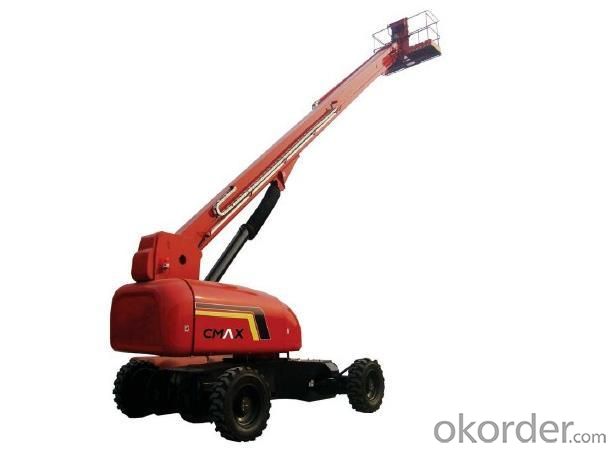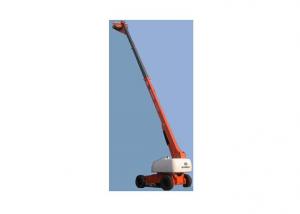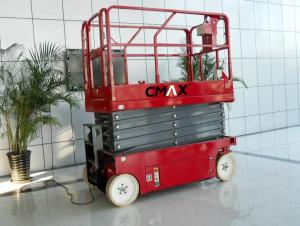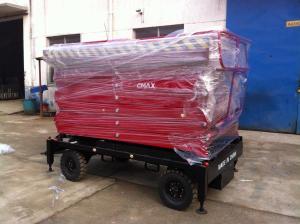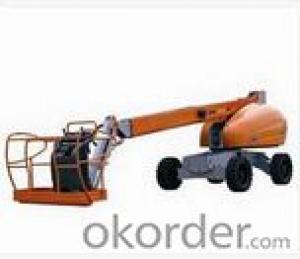Boom Lift and Scissor Lifts
- Loading Port:
- China Main Port
- Payment Terms:
- TT or L/C
- Min Order Qty:
- -
- Supply Capability:
- 50 Sets Per Month m.t./month
OKorder Service Pledge
OKorder Financial Service
You Might Also Like
Boom Lift SPECIFICATION
Boom Lift Max. working height(m): 16
Boom Lift Travelling when lifts(kg): 8100(12 boom)
Max. lifting torque(kN m): 2062
Boom length: 12~30(standard configuration 18m)
Boom Lift Working range: 4~29(outriggers extended)
Boom Lift Elevation range: 22~77
Max. lifting height(mm): 27650 (with 30 boom)
Boom Lift Axle base(mm): 2650+1300
Boom Lift Wheel base fromt/rear(mm): 2400/2400
Ground clearance(mm):225
Boom Lift Gradeability(%):21
Min. turning diameter(m): 20
GVW(with 12m boom)(kg): 49700
Boom Lift Outigger type: H type
Machine dimension(without boom)(L×W×H)(mm): 7460× 3315× 3710
Machine dimension(with 12m boom)(L×W×H)(mm): 17150× 3315× 3710
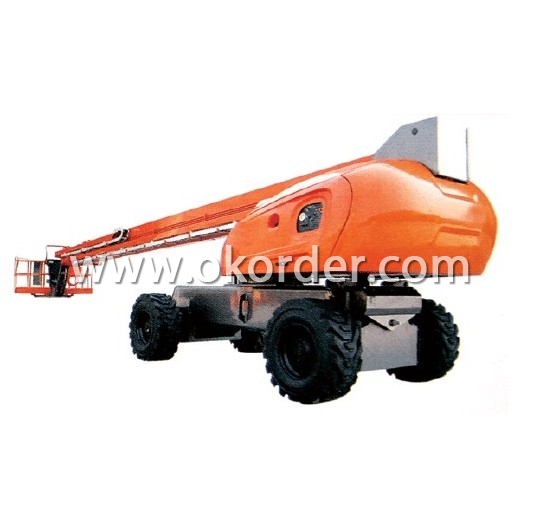
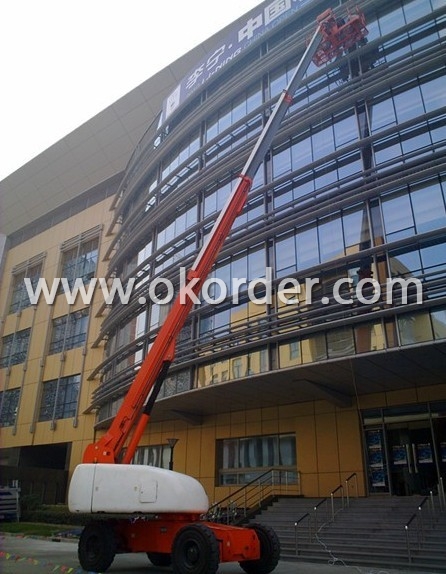
- Q: Is it possible to utilize a building hoist for the purpose of lifting heavy equipment or machinery?
- <p>Yes, a building hoist can be used for lifting heavy equipment or machinery, provided it has the necessary capacity and safety features. These hoists are designed to handle substantial loads and are commonly used in construction for moving materials and equipment. However, it's crucial to ensure that the hoist is rated for the weight of the equipment, and all safety protocols are followed to prevent accidents. Regular maintenance and inspection are also essential to ensure the hoist's reliability and safety during heavy lifting operations.</p>
- Q: This question asks for a comparison of the pros and cons of utilizing hydraulic cylinders in the context of building hoists.
- <p>Hydraulic cylinders in building hoists offer several advantages, including high force output, compact size, and precise control. They provide smooth and controlled lifting, which is crucial for heavy construction materials. Additionally, hydraulic systems can generate large amounts of force with relatively small cylinders, making them space-efficient. The disadvantages include potential leaks, which can be hazardous, and the need for regular maintenance to ensure the system's reliability. Hydraulic systems can also be more complex to install and repair compared to electric or manual systems. Furthermore, they require a constant power source, which might not always be readily available on construction sites.</p>
- Q: Is it permissible to utilize personal lifting gear for the purpose of lifting objects?
- <p>Yes, you can use your own lifting equipment to lift objects, provided it meets safety standards and is suitable for the weight and type of objects being lifted. Always ensure that the equipment is in good working condition, and you are trained in its proper use to prevent accidents. Compliance with local regulations and guidelines is also crucial to avoid any legal repercussions.</p>
- Q: Can a building hoist be utilized for lifting objects that exceed the lifting capacity of an individual?
- <p>Yes, building hoists are specifically designed to lift heavy objects that are beyond the capacity of a single person. They are engineered to handle substantial weight, making them ideal for construction sites where heavy materials need to be moved to various heights safely and efficiently. By using a building hoist, multiple heavy items can be transported at once, reducing manual labor and the risk of injury associated with heavy lifting.</p>
- Q: This question asks for the method to determine the maximum weight a building hoist can lift.
- <p>The lifting capacity of a building hoist is calculated by considering several factors including the hoist's motor power, the strength of the hoist's construction materials, and the safety factor. The manufacturer usually provides the maximum lifting capacity based on these factors. To calculate it manually, you would need to know the motor's lifting force, the efficiency of the hoist's mechanical system, and apply a safety factor to ensure the hoist operates within safe limits. It's important to follow the manufacturer's guidelines and never exceed the specified lifting capacity to prevent accidents and ensure the hoist's longevity.</p>
- Q: This question asks for guidance on selecting an appropriate building hoist, which is a type of lifting equipment used in construction.
- <p>Choosing a suitable building hoist involves considering several factors. First, assess the lifting capacity needed based on the weight of materials to be moved. Consider the hoist's speed and lifting height to ensure it meets project requirements. Evaluate the safety features, such as overload protection and emergency stop mechanisms. Check the hoist's durability and maintenance needs, as well as its compatibility with the building's structure. Consult with hoist manufacturers or rental companies for recommendations tailored to your specific project. Always prioritize safety and ensure the hoist complies with local regulations and standards.</p>
- Q: What are the financial expenses associated with buying and keeping a building hoist in good condition?
- <p>The costs of purchasing and maintaining a building hoist include the initial purchase price, which can range from $10,000 to $50,000 depending on the hoist's capacity and features. Maintenance costs involve regular inspections, lubrication, and part replacements, averaging around $1,000 to $3,000 per year. Operating costs include labor for hoist operation and potential rental fees if the hoist is not owned. Additionally, there may be costs for safety training and compliance with regulations. These costs can vary widely based on the specific hoist model, usage frequency, and local regulations.</p>
- Q: What are the primary roles or purposes that a building hoist serves in construction?
- <p>Building hoists, also known as construction hoists, serve several essential functions in construction projects. They are primarily used for the vertical transportation of workers, materials, and equipment within a building under construction. They increase efficiency by reducing the time and effort required to move materials and personnel, ensuring a faster construction process. Hoists also enhance safety by providing a controlled and secure means of vertical transportation, reducing the risk of accidents associated with manual material handling. Additionally, they contribute to the overall project timeline by allowing for simultaneous work on multiple floors, improving the coordination of construction activities.</p>
- Q: What precautions should be taken when using manual lifting equipment to ensure safety?
- <p>Safety measures for using manual lifting devices include inspecting equipment for damage before use, ensuring the load is within the device's weight capacity, using proper lifting techniques, maintaining a clear path for lifting, and securing the load to prevent shifting. Always wear appropriate personal protective equipment, such as gloves and safety shoes. Never exceed the rated capacity of the lifting device, and avoid sudden or jerky movements that could cause loss of control. Regular maintenance and training on safe lifting practices are also crucial to prevent accidents.</p>
- Q: How many meters is the wall of the construction elevator?
- It seems that there is no, just the local code, you search for the construction elevator acceptance specification look, I have searched this aspect before, now forget.
1. Manufacturer Overview
| Location | Beijing,China |
| Year Established | 2003 |
| Annual Output Value | Below US$1 Million |
| Main Markets | Mid East;Western Europe;North America |
| Company Certifications | ISO9001:2008 Certificate |
2. Manufacturer Certificates
| a) Certification Name | |
| Range | |
| Reference | |
| Validity Period |
3. Manufacturer Capability
| a) Trade Capacity | |
| Nearest Port | Shanghai |
| Export Percentage | 1% - 10% |
| No.of Employees in Trade Department | 1000 People |
| Language Spoken: | English;Chinese;Japanese |
| b) Factory Information | |
| Factory Size: | Above 300,000 square meters |
| No. of Production Lines | Above 10 |
| Contract Manufacturing | OEM Service Offered;Design Service Offered |
| Product Price Range | Average |
Send your message to us
Boom Lift and Scissor Lifts
- Loading Port:
- China Main Port
- Payment Terms:
- TT or L/C
- Min Order Qty:
- -
- Supply Capability:
- 50 Sets Per Month m.t./month
OKorder Service Pledge
OKorder Financial Service
Similar products
Hot products
Hot Searches
Related keywords





